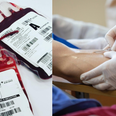In a speech at the London School of Economics on Monday, Ireland’s Minister for Equality Aodhán Ó Ríordáin announced that the government would be dramatically revising its attitude towards drug addiction in Ireland through a stream of new policy initiatives.
Foremost among these new policies is the introduction of supervised injection facilities (SIFs) for drug users, to be opened in Dublin, Cork, Galway and Limerick.
The move represents what the Minister calls a ‘radical shift’ in Ireland’s approach to combatting drug addiction – but a shift that has already taken in place in many other countries, which gives us a clue as to the effects that it may have.
Tony Duffin, Director of addiction outreach programme The Ana Liffey Foundation spoke to JOE.ie about Ireland’s new attitude towards drug addiction:
“SIFs will reduce the shame of public injection and get rid of the barrier between addicts and professional people who can help, and have a real conversation with users in real time.
“Users will get referred to healthcare facilities faster and things like their social circumstances and their housing situations will be assessed.”
Seeking to allay fears that injection rooms encourage people to inject drugs, Duffin said “while it may seem counter-intuitive, there is no evidence from Sydney or Vancouver that these clinics lead to an increase in drug use.
“Instead, they reduce the risk of blood-borne viruses and save the public money by hugely reducing the number of ambulance callouts for overdoses, and reduce the huge strain placed on A&Es.”
Duffin was quick to emphasise, however, that safe injections clinics “are not a silver bullet.”
Duffin, who has worked in the Kings Cross clinic in Sydney told us that “this will not remove the problem of drugs, but it will improve it. Getting users in to see people from the clinical care and social care side is part of a process. Every alley way in Dublin will be used for a heroin injection at some point during a week, this will go a long way to improving that.”
Thanks to @lseideas for organising today's discussion on progressive drug policy.@drugscrisis @AnaLiffey https://t.co/SliYK2Ezqs
— Aodhán Ó Ríordáin (@AodhanORiordain) November 2, 2015
The first SIF was opened over thirty years ago in Switzerland. Since then, Norway, Luxembourg, Germany and several other developed nations have opened their own SIFs. There are currently about 100 of these facilities worldwide.
A ‘typical’ SIF is located in an area densely populated by drug addicts. The facility will have a reception where visitors sign in before they are led to a room with any number of booths or private spaces.
Drug users will be given a sterile syringe, a tourniquet and saline solution, and will be observed at all times by trained medical staff. Often, there will be a decompression room where users can relax after injecting, as well as nursing, counselling and welfare staff who can refer users to health, social or housing services where appropriate.
A growing body of evidence strongly suggests that these SIFs contribute to reductions in needle-sharing, overdoses, public injecting and publicly discarded syringes.
It is also reasoned that less judgmental, persecutory policies towards drug use and drug addiction can and will encourage engagement with detoxification programmes and addiction treatment programmes.
A 2010 report by The Journal of Global Drug Policy and Practice confirms the often-quoted statistic that, to date, there have been no deaths from overdose in SIFs.
The problem that persists, according to the report, is that even those drug users who make use of SIFs do not do so every time they are using drugs, and that there is often no actual decrease in overdoses in the area served by the facility.
Sydney’s Medically Supervised Injecting Centre (MSIC), which opened in 2001, released details of the centre’s progress in 2011:
- The centre successfully managed more than 4,400 overdoses without a single fatality
- The centre halved the number of discarded needles and syringes in the Kings Cross area
- The centre decreased the number of ambulance call outs to Kings Cross by 80%
- The centre generated more than 9,500 referrals to health and social services
These improvements are not limited to Sydney. Since the 1980s, SIFs have managed millions of injections with only one death (which was a result of anaphylaxis, an allergic reaction, not overdose). Fears that SIFs serve as an attraction for drug users and drug dealers to relocate in that area are also largely unsubstantiated, according to a 2006 report by the Independent Working Group on Drug Consumption Rooms.
There is a clear consensus among studies conducted into the benefits of drug SIFs that they do not eradicate the wider problem of hard drug use, nor do they play a direct role in reducing or treating drug addiction.
However, claims that the supervised centres lead to an increase in crime, an increase in addiction or an increase in public nuisance are also unfounded.
A hot meal. A helping hand. A fresh start. 💜 Thank you to all our volunteers, staff & supporters. 💜💜💜 #CharityDay pic.twitter.com/dQvZhmp5wH
— Merchants Quay Ireland (MQI) (@MerchantsQuayIR) September 5, 2015
What SIFs have successfully provided in other countries like Ireland, such as Denmark, are a protected atmosphere wherein addicts can take dangerous drugs in such a way that immediate harm is unlikely to come to them or anyone else.
Beyond that, it is widely agreed that further efforts are needed to actually bring down the rate of drug use and the widespread availability of hard drugs.
SIFs do not open 24 hours a day, seven days a week. Furthermore, they can reach their capacity. The Drug Free Australia 2010 analysis found that of all the heroin users who visited the MSIC in Kings Cross, Sydney between 10-98 times in a year still performed 95% of their injections on the street, in a car, a toilet, at their own home or in somebody else’s home.
It must be concluded, therefore, that the mere presence of supervised injection rooms is not a sufficient measure to attract regular drug users to the site for even a small fraction of their injections.
That is why it is important to understand the immediate goals that can be achieved by SIFs. What these facilities do is offer drug users the option of a much safer environment, some of the time. As important will be the “integrated approach to treatment and rehabilitation based on a continuum of care with clearly defined referral pathway” Minister O’Ríordain spoke about in his speech on Monday.
LISTEN: You Must Be Jokin’ with Aideen McQueen – Faith healers, Coolock craic and Gigging as Gaeilge





















































